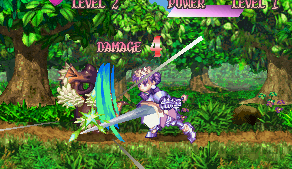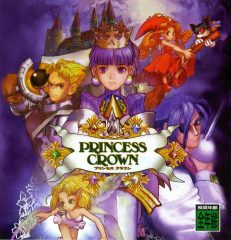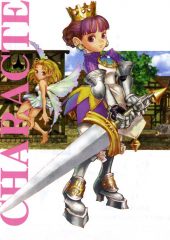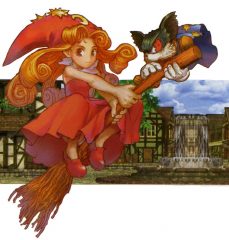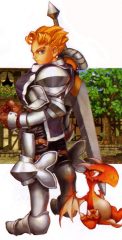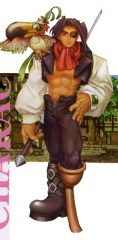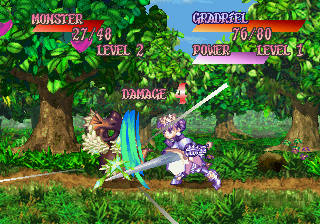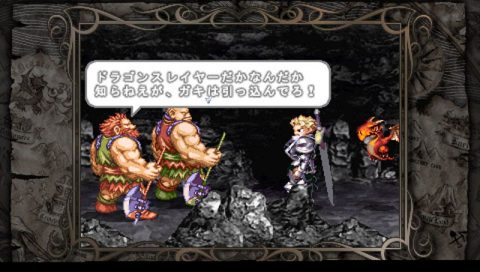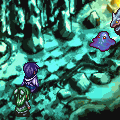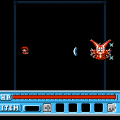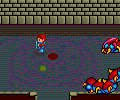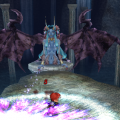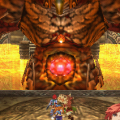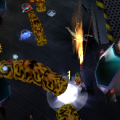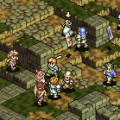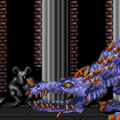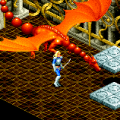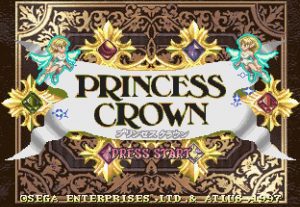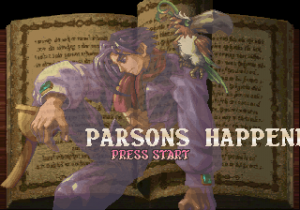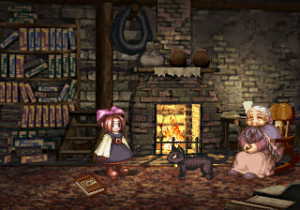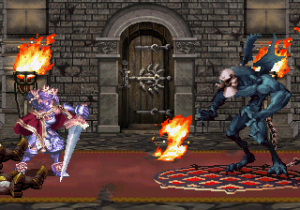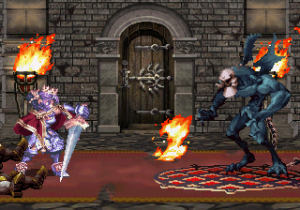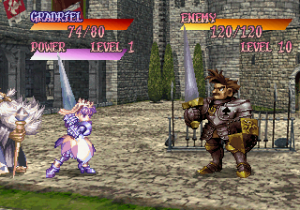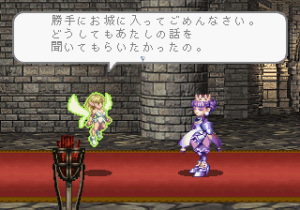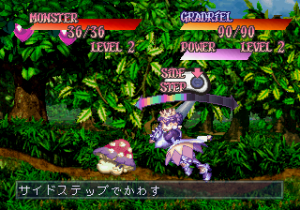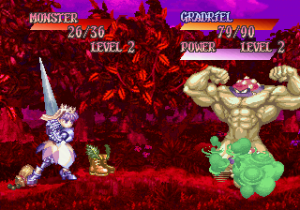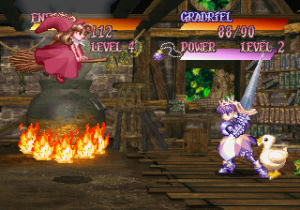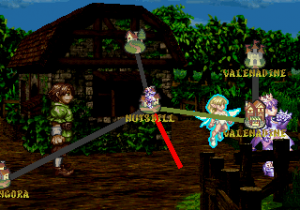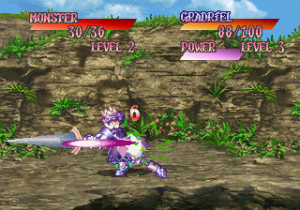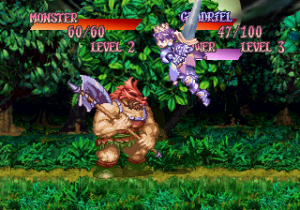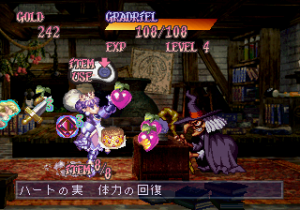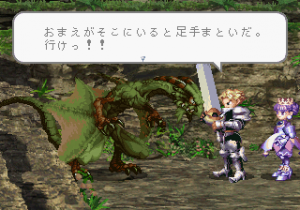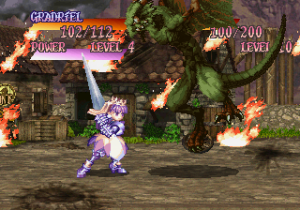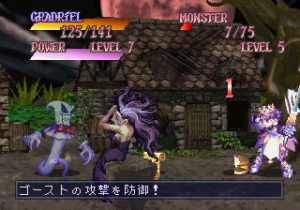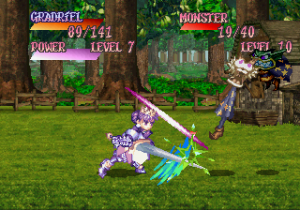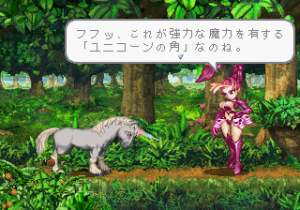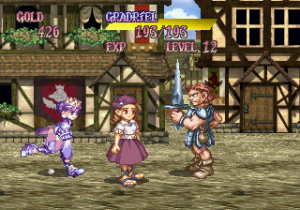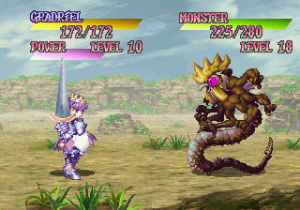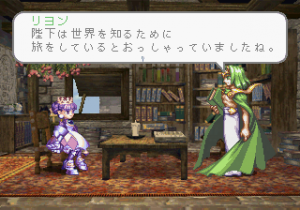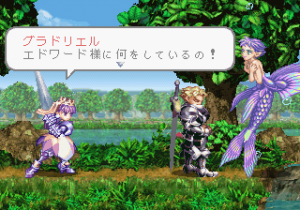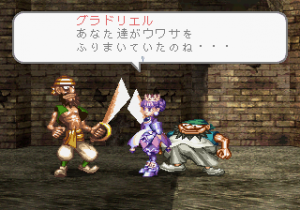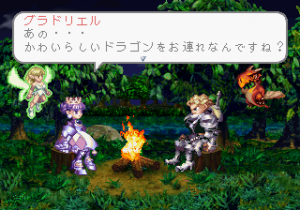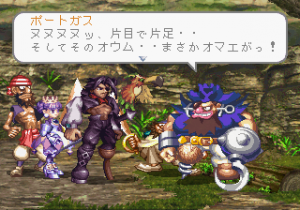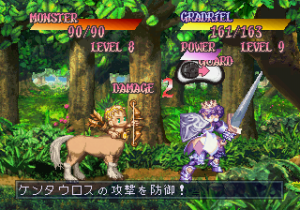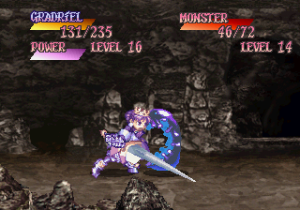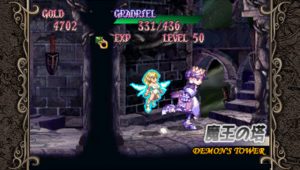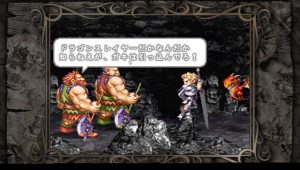Japanese game developer Vanillaware has a long standing reputation for absolutely gorgeous 2D visuals, with titles including Odin Sphere, Muramasa: The Demon Blade, Grand Knights History, Grim Grimoire, and Dragon’s Crown. The signature style is primarily due to artist George Kamitani, who got his start in the video game business as a graphic designer for Capcom on their Dungeons and Dragons beat-em-ups. He was later put in charge in Princess Crown, a joint effort between Atlus and Sega, in the later days of the Sega Saturn. As a gorgeous side-scrolling action-RPG, it’s effectively the origin of Vanillaware’s games, if not quite in name, as the company hadn’t been established yet.
Princess Crown takes place in the kingdom of Valendia, which, unlike medieval kingdoms in most traditional fantasy stories, is a matriarchy. The intro shows the queen kicking the ass to some invading monsters, before forwarding to the present day. The young princess Gradriel has been put in charge of the kingdom, and begins listening to the pleas of her subjects. There’s all kinds of trouble afoot, ranging from witches that are kidnapped to kids to dragons that are terrorizing the populace. She’s advised to let the knights take care of these issues, but Gradriel decides to sneak out of the castle to observe everything firsthand. Naturally, life outside the castle isn’t quite as she’d imagined it, especially when her sister and kidnapped, and she learns of an evil sorceress summoning great evil, who is naturally out to destroy everything.
Characters
Although Gradriel is the main character, she’ll run across the others several times during the course of the story. After finishing the game, each of the three side characters star in their own playable story, which intersect with Gradriel’s tale and retell the same events from a different points of view. None of the dialogue is voice acted, and outside of the introduction, doesn’t really feature anything in the way of cinematic cutscenes.
The kingdom of Valendia consists of several towns, along with your standard castles and caves. Each of these locations is connected by straight pathway. Whenever you reach the end of a path, you’re given a choice of your next destination, if the path branches. This allows free exploration of the kingdom without having to deal with menus or map screens. Your characters aren’t exactly speed demons, and even when running, travelling between destinations can be extremely slow. Thankfully you can travel between certain towns through the use of magical transportation shops. The storyline is pretty linear, and requires that you talk to as many villagers as possible, since that’s the only way to open up new locations on the map. Thankfully, any time you learn of a new location, the text is colored, which definitely helps if you’re not fluent in Japanese, and there are detailed FAQs that point you in the direction. There are a number of subquests that involve branching off into different directions, some of which allow you to create more powerful items or make certain boss fights easier.
Princess Crown earned its reputation by featuring some of the most gorgeous 2D graphics around. All of the sprites are huge, with most taking up roughly half the screen, and all are meticulously animated. These effects are most apparent with the dragons, who flap their wings and breath so fluidly that it makes practically every other 2D effort look cheap. It’s not quite to the levels of Street Fighter III or Garou: Mark of the Wolves (still the highest levels of 2D sprite animation), but it comes close.
But ultimately, it’s the little graphical touches that give Princess Crown so much personality. When walking, Gradriel slowly saunters forward, peering up and around and surveying the landscape. When running, she holds her arms outstretched at her sides and runs like a prim and proper young lady. Whenever she eats anything, she puts her hands to her mouth and swallows. She leaps up and down with glee whenever she gains a level. And despite how girly she looks, she also appears surprisingly menacing whenever she brandishes a sword. Gradriel doesn’t actually carry her blade on her (which is at least half the size of her body) but is delivered to her by her fairy familiar at the beginning of each battle, and whisked away just as quickly during the victory screen. These animations do a better job of illustrating Gradriel’s character than any number of dialogue boxes, which is something some JRPG script writers should pay attention to.
The enemies have just as much care put into them. The goblins are all cute and fuzzy and malicious all at the same time. The expressions on their faces when they get smashed are priceless, echoing any number of Warner Bros. cartoons. Another enemy, a centaur, will shoot arrows into the air and occasionally hit birds in the sky, which will then fall to the earth and can be used as meat. Ghosts will bless themselves with the sign of the cross before expiring. Sure, many of the enemies are recycled over and over – there are tons of palette swaps – but this isn’t any worse than most standard RPGs.
While the sprites are gorgeous, the backgrounds didn’t receive quite the same amount of care. It’s not that they don’t look good – they’re colorful and detailed – but they’re also incredibly repetitive. The layouts are never anything more than straight paths, with almost no variation. Many arenas look identical, and it’s hard to tell many of the towns apart from one another. This isn’t really a big deal until you start getting to the caves and castles, which are mazes consisting of the same room pasted over and over dozens of times. You’re given a map, but it’s not as useful as you’d expect it to be.
On a similar note, Atlus didn’t pay much mind to the soundtrack either. It’s all flavorless, generic fantasy synth, and would probably go in one ear and pass immediately out from the other, if only the music weren’t repeated so often. All of the music is CD audio, and there are only sixteen music tracks, which means you get to hear the same cheery yet banal town theme over and over. There’s not even any music when exploring, making for a very quiet journey. The soundtrack is credited to Toshikazu Tanaka, most likely the same person who worked on many SNK games and later developed a totally rocking, distinctive style in games like King of Fighters Maximum Impact and Metal Slug 4, but unfortunately none of that talent shows through here.
When running throughout most of the pathways – which you’ll need to do a lot, since you’ll need to backtrack quite a bit, and some of the dungeons are expansive – you’ll randomly get attacked by enemies. Unfortunately, it’s here where Princess Crown stumbles. These battles are technically one-on-one, although occasionally you’ll come across groups of enemies that tag-team in and out of combat. The fighting system is pretty odd because it sets itself up like a 2D fighter – you press Up to jump and hold Back to block – but it doesn’t flow like one. Your movements are all extremely slow and deliberate, to the point where everything feels sluggish. There are only three types of strikes – your standard combo, executed by hitting the Attack button; a running slash, executed by holding Down and pressing Attack; and a super blow, executed by holding the Attack button for a few seconds. All three are slow and awkward, and the fighting system desperately begs for a quick jab maneuver. And while you can launch jumping attacks, good luck hitting anything with it.
It doesn’t help that enemies are usually much more agile, can routinely break out of your combos, and even counterattack, constantly putting you at a disadvantage. You can shift back forth and effortlessly, but it’s not exactly useful. There is a faster dash maneuver which, oddly enough, can only be executed right before an opponent attacks you. By pressing the B button right before an enemy strikes, the action will freeze and you can choose to either dash past the enemy to flank them, or slide backward in retreat. Which begs the question – why can’t you do this whenever you want? And why does the game have to pause, which completely disrupts the action?
Putting space between yourself and your foe is one of the biggest issues you’ll have to deal with in Princess Crown, primarily due to the POW meter. You begin each match with your POW meter at 50%. It increases slowly if you walk around, although if you stand completely still, it’ll fill up faster. Almost any offensive or defensive action – attacking, blocking or dashing – drains a bit of the POW meter. It’s supposed to regulate button mashing by forcing you to back off from close encounters, lest you find yourself with zero POW, which essentially means you’re defenseless. The problem is that the POW meter drains way too quickly and doesn’t refill fast enough. This results in far too many situations where the enemy can get in multiple cheap hits – God forbid you get cornered, because your characters simply aren’t agile enough to escape most traps. At least your familiars will occasionally pop onto the screen and score some quick hits on your opponent, which can serve to save your butt from getting repeatedly beaten down.
Annoyingly enough, the POW meter drains whenever you’re blocking, regardless of whether you’re actually getting hit. So you might be trying to retreat to the other side of the screen, but since you’re holding backwards and the enemy is attacking from across the screen, you’ll get stuck in a block stance – so you’re not only motionless, but losing precious POW as well. On a similarly annoying note, the camera focuses on the enemy’s movement instead of yours – so you might be trying to back away from a foe, but the screen will remain static since your opponent isn’t moving. The whole one-on-one fighting aspect is such an interesting concept that it begs for a tighter combat system – but Samurai Shodown, this most certainly ain’t.
Because of all of these issues, there’s only one real way to fight enemies in Princess Crown – use a dash attack, get in a quick hit, then slam your foe to the ground with a charged attack. Although faster enemies can dodge out of this, it works on a majority of foes, and most battles can be won by using this same string of attacks over and over and over. As a result, combat teeters on a fine line between boredom and frustration.
While the melee fighting options are limited, there are a number of secondary attack methods. You’ll find limited use projectile items like daggers and axes (which pretty much work the same way that they do in Castlevania), as well as staves and jewels, which cast a variety of attack spells. But even then, there are some annoying issues – instead of using an MP system or something to that effect, most of the magic are contained in limited use gems, which take up valuable inventory space. Additionally, most magic gems are useless unless they’re “activated”, which is done with certain items. All of this just leads to even more clutter in your backpack. Most of these attacks are also pretty weak – however, the close combat system is so broken that the most effective approach is usually to weaken foes with secondary attacks and hope you have enough health left to win a war of attrition. There are a bunch of items to find and equip, some of which will absorb damage, others which will automatically execute a dash whenever you’re about to be attacked, and still others which will raise resistance to various status ailments. You can only equip one at a time, however, and they break pretty quickly, requiring you to constantly cycle through new items.
The game seems to acknowledge the weaknesses of the fighting system, because healing items are fairly plentiful. Some enemies randomly drop half-eaten cupcakes and hamburgers, most dungeons have numerous treasure chests, and a few areas even have hordes of apples growing on trees, a quick and easy way to restore your health. Your life meter is generously refilled every time you gain a level, which happens reasonably often. You can also plant seeds (although only in battles) which will not only yield health restoring fruit, but more seeds as well, allowing you to plant over and over ad infinitum. You’ll run across other items like spices and meat, which can’t be consumed normally, but can be cooked at various cafes to turn them into powerful healing items. It’s more than a bit aggravating to bring up your inventory and find that you can’t eat that piece of corn you found, because it hasn’t been cooked yet. (Both of these aspects were expanded greatly in its follow-up, Odin Sphere.)
Since there are all of these healing options, and you can take quite a bit of damage before croaking, Princess Crown isn’t technically a difficult game. However, it is maddeningly unforgiving. You only have a single life, and if you get killed, you get sent back to the last save point. Save points, by the way, are not at all common. Dying and having to rewatch the same cutscenes over and over is slightly annoying. Dying and having to replay thirty minutes of boring dungeon crawling is even worse. And while the Engrish game over screen (“Falldown from the Bookworld”) is cute the first time you see it, it quickly wears out its welcome.
The only truly difficult battles in Princess Crown are the boss fights, which require you to be well stocked with healing items. But the game can’t even give you a break with something as simple as eating food. In the fury of combat, your character is completely vulnerable for a few seconds while you’re eating. And if you get hit in the meantime, you’ll drop whatever you’re eating on the floor and need to retrieve it. However, you can’t leave any item on the ground for too long (roughly twenty seconds or so) before a stupid little goblin steals it away. What if you planted a tree at the beginning of battle, and while it’s taken time to sprout, the enemy has cornered you on the other side of the screen? If you can’t get back fast enough to retrieve the fruit – and you certainly don’t have the moves to get there quickly – then they’ll be stolen away, your effort completely wasted.
Inventory management is another low point to Princess Crown. You have several bags, each of which can hold ten items, but only one is accessible during combat. Therefore, you need to pick which items should be a priority, and relegate the less important goods to your backpack. Furthermore, there are all kinds of treasures that’ll end up getting stolen because you don’t have any open slots in your inventory. Just trying to sell anything is maddening, because you need to open up slots in your primary inventory, transfer any goods from your backpack, then talk to a merchant to unload your goods. Depending on how many items you want to sell and how much stuff you have, you may need to do this multiple times.
These is a seemingly insignificant complaint, but it’s symptomatic of a larger problem. There’s some really cool concepts at work in Princess Crown, both mechanically and visually, and it’s certainly unlike any other action-RPG ever made. But it also could’ve used a bit of polish – Atlus definitely put far more work into animating the sprites than tuning the combat, resulting in a tragically classic case of “graphics over gameplay”. And the role playing aspects are too frustratingly clunky to really add much. And yet, these aspects may not matter – if you’re not into fighting or action games, the issues with the combat may take some getting used to, but not be a massive problem. But even then, it’s a bit slow moving, and could’ve definitely used a bit of speed to kick the pace.
According to interviews with director George Kamitani, Princess Crown didn’t sell particularly well, although its reputation allowed it to be reprinted under the “Sega Kore” (Sega Collection) label. In 2005, it was ported to the PSP. And like most PSP ports, it’s a pretty lazy conversion, which doesn’t bother to refit the screen to the widescreen resolution of the portable system, resulting in either nasty borders or an ugly stretched image. Other than an art gallery, nothing much has been added or changed, other than status indicators that display the name of the area you’re in. It’s still an acceptable alternative to the Saturn version at least, because the game itself is pretty faithful. Alas, despite again selling enough to garner a budget rerelease, it’s still only available in Japan.
